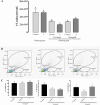Molecular iodine exerts antineoplastic effects by diminishing proliferation and invasive potential and activating the immune response in mammary cancer xenografts
- PMID: 30902074
- PMCID: PMC6431076
- DOI: 10.1186/s12885-019-5437-3
Molecular iodine exerts antineoplastic effects by diminishing proliferation and invasive potential and activating the immune response in mammary cancer xenografts
Abstract
Background: The immune system is a crucial component in cancer progression or regression. Molecular iodine (I2) exerts significant antineoplastic effects, acting as a differentiation inductor and immune modulator, but its effects in antitumor immune response are not elucidated.
Methods: The present work analyzed the effect of I2 in human breast cancer cell lines with low (MCF-7) and high (MDA-MB231) metastatic potential under both in vitro (cell proliferation and invasion assay) and in vivo (xenografts of athymic nude mice) conditions.
Results: In vitro analysis showed that the 200 μM I2 supplement decreases the proliferation rate in both cell lines and diminishes the epithelial-mesenchymal transition (EMT) profile and the invasive capacity in MDA-MB231. In immunosuppressed mice, the I2 supplement impairs implantation (incidence), tumoral growth, and proliferation of both types of cells. Xenografts of the animals treated with I2 decrease the expression of invasion markers like CD44, vimentin, urokinase plasminogen activator and its receptor, and vascular endothelial growth factor; and increase peroxisome proliferator-activated receptor gamma. Moreover, in mice with xenografts, the I2 supplement increases the circulating level of leukocytes and the number of intratumoral infiltrating lymphocytes, some of them activated as CD8+, suggesting the activation of antitumor immune responses.
Conclusions: I2 decreases the invasive potential of a triple negative basal cancer cell line, and under in vivo conditions the oral supplement of this halogen activates the antitumor immune response, preventing progression of xenografts from laminal and basal mammary cancer cells. These effects allow us to propose iodine supplementation as a possible adjuvant in breast cancer therapy.
Keywords: Immune response; Iodine; MCF-12F; MCF-7; MDA-MB231; Mammary cancer; Molecular iodine; PPARγ; Xenografts.
Conflict of interest statement
Ethics approval
All procedures followed the
Competing interests
The authors declare that they have no competing interests.
Publisher’s Note
Springer Nature remains neutral with regard to jurisdictional claims in published maps and institutional affiliations.
Figures






Similar articles
-
Molecular iodine impairs chemoresistance mechanisms, enhances doxorubicin retention and induces downregulation of the CD44+/CD24+ and E-cadherin+/vimentin+ subpopulations in MCF-7 cells resistant to low doses of doxorubicin.Oncol Rep. 2017 Nov;38(5):2867-2876. doi: 10.3892/or.2017.5934. Epub 2017 Sep 1. Oncol Rep. 2017. PMID: 28901484
-
Molecular iodine/doxorubicin neoadjuvant treatment impair invasive capacity and attenuate side effect in canine mammary cancer.BMC Vet Res. 2018 Mar 12;14(1):87. doi: 10.1186/s12917-018-1411-6. BMC Vet Res. 2018. PMID: 29530037 Free PMC article.
-
1,1-Bis(3'-indolyl)-1-(p-biphenyl)methane inhibits basal-like breast cancer growth in athymic nude mice.Breast Cancer Res. 2007;9(4):R56. doi: 10.1186/bcr1761. Breast Cancer Res. 2007. PMID: 17764562 Free PMC article.
-
6-iodolactone, key mediator of antitumoral properties of iodine.Prostaglandins Other Lipid Mediat. 2014 Aug;112:27-33. doi: 10.1016/j.prostaglandins.2014.07.001. Epub 2014 Jul 10. Prostaglandins Other Lipid Mediat. 2014. PMID: 25018052 Review.
-
Peroxisome proliferator-activated receptors: role of isoform gamma in the antineoplastic effect of iodine in mammary cancer.Curr Cancer Drug Targets. 2011 Sep;11(7):775-86. doi: 10.2174/156800911796798931. Curr Cancer Drug Targets. 2011. PMID: 21762085 Review.
Cited by
-
The POLR3G Subunit of Human RNA Polymerase III Regulates Tumorigenesis and Metastasis in Triple-Negative Breast Cancer.Cancers (Basel). 2022 Nov 22;14(23):5732. doi: 10.3390/cancers14235732. Cancers (Basel). 2022. PMID: 36497214 Free PMC article.
-
Iodine-Biofortified Lettuce Can Promote Mitochondrial Dependent Pathway of Apoptosis in Human Gastrointestinal Cancer Cells.Int J Mol Sci. 2023 Jun 7;24(12):9869. doi: 10.3390/ijms24129869. Int J Mol Sci. 2023. PMID: 37373017 Free PMC article.
-
Molecular Iodine Induces Anti- and Pro-Neoplastic Effects in Prostate Cancer Models.Int J Mol Sci. 2025 Aug 13;26(16):7800. doi: 10.3390/ijms26167800. Int J Mol Sci. 2025. PMID: 40869121 Free PMC article.
-
Molecular Iodine/Cyclophosphamide Synergism on Chemoresistant Neuroblastoma Models.Int J Mol Sci. 2021 Aug 19;22(16):8936. doi: 10.3390/ijms22168936. Int J Mol Sci. 2021. PMID: 34445656 Free PMC article.
-
Analysis of Urinary Iodine Concentration in Differentiated Thyroid Cancer and Breast Cancer Cases.Asian Pac J Cancer Prev. 2024 Jun 1;25(6):1869-1873. doi: 10.31557/APJCP.2024.25.6.1869. Asian Pac J Cancer Prev. 2024. PMID: 38918646 Free PMC article.
References
MeSH terms
Substances
Grants and funding
LinkOut - more resources
Full Text Sources
Medical
Research Materials
Miscellaneous

